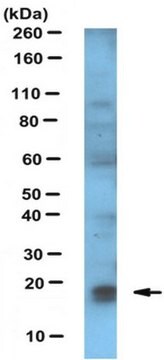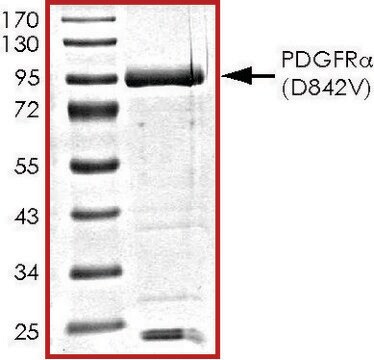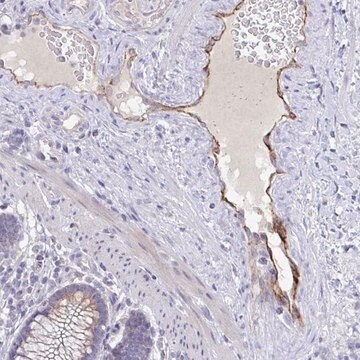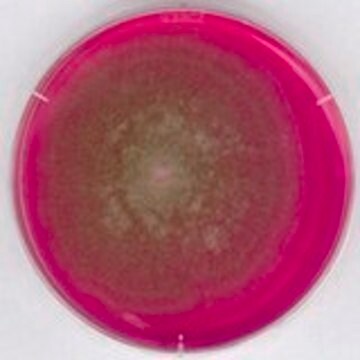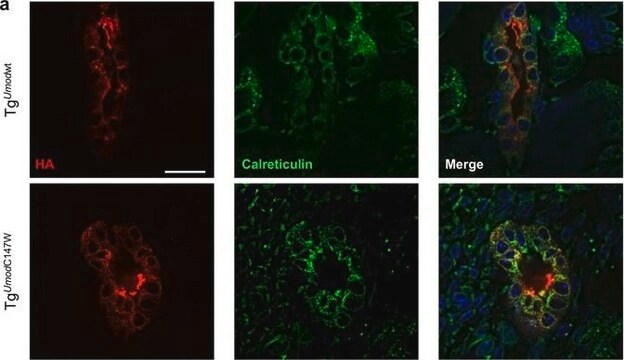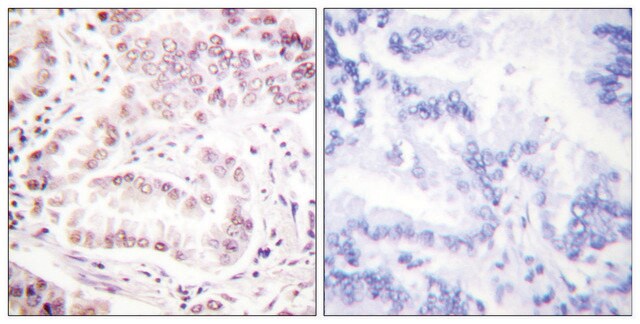추천 제품
생물학적 소스
mouse
Quality Level
항체 형태
purified antibody
항체 생산 유형
primary antibodies
클론
4F1, monoclonal
분자량
calculated mol wt 18 kDa
observed mol wt ~18 kDa
정제법
using protein G
종 반응성
human
포장
antibody small pack of 100
기술
immunocytochemistry: suitable
immunoprecipitation (IP): suitable
western blot: suitable
동형
IgG2cκ
에피토프 서열
Unknown
단백질 ID 수납 번호
UniProt 수납 번호
저장 온도
2-8°C
유전자 정보
human ... UBD(10537)
특이성
Clone 4F1 is a mouse monoclonal antibody that detects FAT10/Ubiquitin D.
면역원
GST-tagged recombinant human FAT10/Ubiquitin D.
애플리케이션
Quality Control Testing
Evaluated by Western Blotting in lysate from HepG2 cells treated with IFN and TNF .
Western Blotting Analysis: A 1:1,000 dilution of this antibody detected FAT10 in lysate from HepG2 cells treated with IFN and TNF (200 and 400 units, respectively for 16 h), but not in lysate from untreated HepG2 cells.
Tested Applications
Immunocytochemistry Analysis: A 1:50 dilution from a representative lot detected FAT10/Ubiquitin D in HepG2 cells.
Western Blotting Analysis: A representative lot detected FAT10/Ubiquitin D in Western Blotting application (Aichem, A., et al. (2012). J Cell Sci. 125(Pt19):4576-85; Aichem, A., et al. (2010). Nat Commun.;1:13).
Immunocytochemistry Analysis: A representative lot detected FAT10/Ubiquitin D in Immunocytochemistry applications (Aichem, A., et al. (2012). J Cell Sci. 125(Pt19):4576-85).
Immunoprecipitation Analysis: A representative lot immunoprecipitated FAT10/Ubiquitin D in Immunoprcipitation applications (Aichem, A., et al. (2012). J Cell Sci. 125(Pt19):4576-85).
Note: Actual optimal working dilutions must be determined by end user as specimens, and experimental conditions may vary with the end user.
Evaluated by Western Blotting in lysate from HepG2 cells treated with IFN and TNF .
Western Blotting Analysis: A 1:1,000 dilution of this antibody detected FAT10 in lysate from HepG2 cells treated with IFN and TNF (200 and 400 units, respectively for 16 h), but not in lysate from untreated HepG2 cells.
Tested Applications
Immunocytochemistry Analysis: A 1:50 dilution from a representative lot detected FAT10/Ubiquitin D in HepG2 cells.
Western Blotting Analysis: A representative lot detected FAT10/Ubiquitin D in Western Blotting application (Aichem, A., et al. (2012). J Cell Sci. 125(Pt19):4576-85; Aichem, A., et al. (2010). Nat Commun.;1:13).
Immunocytochemistry Analysis: A representative lot detected FAT10/Ubiquitin D in Immunocytochemistry applications (Aichem, A., et al. (2012). J Cell Sci. 125(Pt19):4576-85).
Immunoprecipitation Analysis: A representative lot immunoprecipitated FAT10/Ubiquitin D in Immunoprcipitation applications (Aichem, A., et al. (2012). J Cell Sci. 125(Pt19):4576-85).
Note: Actual optimal working dilutions must be determined by end user as specimens, and experimental conditions may vary with the end user.
표적 설명
Ubiquitin D (UniProt: O15205; also known as Diubiquitin, UBD, Ubiquitin-like protein FAT10) is encoded by the UBD (also known as FAT10) gene (Gene ID: 10537) in human. FAT10 is a ubiquitin-like modifier protein that is involved in various cellular processes, including apoptosis, cell cycle control, and NF- B activation. It is constitutively expressed in mature dendritic cells and B-cells. Its expression is observed in the reticuloendothelial system, the gastrointestinal system, kidney, lung, and prostate gland. It is detected in the nucleus as well as cytoplasm. It has two ubiquitin-like domains (aa 6-81 and 90-163). It can covalently attach to target protein and lead to their degradation by the 26S proteasome, in a NUB1-dependent manner. Its conjugation ability activated by UBA6. It regulates TNF -induced and LPS-mediated activation of NF- B by promoting TNF - mediated proteasomal degradation of I B . It is reported to mediate mitotic non-disjunction and chromosome instability, in long-term in vitro culture and cancers, by abbreviating mitotic phase and impairing the kinetochore localization of mitotic arrest deficient 2 like 1 (MAD2L1) during the prometaphase stage. It mediates apoptosis in a caspase-dependent manner, especially in renal epithelium and tubular cells during renal diseases such as polycystic kidney disease and HIV-associated nephropathy. p62 protein that is involved in autophagy is covalently mono-FAT10ylated at several lysine residues, which leads to proteasomal degradation of p62. Prolonged induction of endogenous FAT10 by pro-inflammatory cytokines leads to a reduction in endogenous p62 levels. Clone 4F1 displays high-affinity for FAT10 and can immunoprecipitate monomeric FAT10 and FAT10-conjugated substrates. (Ref.: Aichem, A., et al. (2012). J. Cell Sci. 125(19); 4576-4585; Ren, J., et al. (2006). J. Biol. Chem. 281(16); 11413-11421; Ross, MJ., et al. (2006). J. Am. Soc. Nephrol. 17(4); 996-1004; Hipp, MS., et al. (2005). Mol. Cell Biol. 25(9); 3483-3491).
물리적 형태
Purified mouse monoclonal antibody IgG2c in buffer containing 0.1 M Tris-Glycine (pH 7.4), 150 mM NaCl with 0.05% sodium azide.
재구성
1.0 mg/mL. Please refer to guidance on suggested starting dilutions and/or titers per application and sample type.
저장 및 안정성
Recommended storage: +2°C to +8°C.
기타 정보
Concentration: Please refer to the Certificate of Analysis for the lot-specific concentration.
면책조항
Unless otherwise stated in our catalog or other company documentation accompanying the product(s), our products are intended for research use only and are not to be used for any other purpose, which includes but is not limited to, unauthorized commercial uses, in vitro diagnostic uses, ex vivo or in vivo therapeutic uses or any type of consumption or application to humans or animals.
적합한 제품을 찾을 수 없으신가요?
당사의 제품 선택기 도구.을(를) 시도해 보세요.
Storage Class Code
12 - Non Combustible Liquids
WGK
WGK 1
Flash Point (°F)
Not applicable
Flash Point (°C)
Not applicable
시험 성적서(COA)
제품의 로트/배치 번호를 입력하여 시험 성적서(COA)을 검색하십시오. 로트 및 배치 번호는 제품 라벨에 있는 ‘로트’ 또는 ‘배치’라는 용어 뒤에서 찾을 수 있습니다.
자사의 과학자팀은 생명 과학, 재료 과학, 화학 합성, 크로마토그래피, 분석 및 기타 많은 영역을 포함한 모든 과학 분야에 경험이 있습니다..
고객지원팀으로 연락바랍니다.